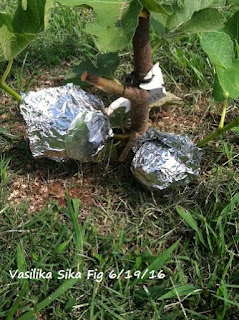This was a fun little project last year that failed to make the blog in my business or laziness, however one wants to think.
It began as an experiment in Etiolation...
Etiolation is a process in flowering plants grown in partial or complete absence of light. It is characterized by long, weak stems; smaller leaves due to longer internodes; and a pale yellow color (chlorosis).
I read in some article about etiolation being used as a treatment to pre-root some plant varieties that were for whatever reason, hard to root cuttings of. There was some success mentioned, don't exactly remember.
So we set out to attempt to induce rooting of fig stems in empty foil balls with darkness and air being the only media, just to see if it would work.
This was the first one...
Kind of crude looking so some other method was thought about and settled on a foam ball mold of sorts, to press foil around and make clam-shells...
Well that turned out pretty good and some more were applied empty and some with different media.
Some peat pellets were laid into these and given different amounts of water. Peat just doesn't work well enough for my liking to say anything more about it.
The next three photo's show root primordia forming in the empty foil balls over a few weeks time.
Root formation in just under a month with only four damp cotton balls laying in one half of the foil ball...
Successful root formation inside an empty foil balls in just under a month.
Next several photo's showing foil ball air layers applied to different trees with different media. Note my trees are young and so they are small and these are all on small stems. Bigger ones would be needed on larger stems so the root ball would support top growth once removed and re-potted.
Damp media is placed into each ball half, it's closed up around the stem and edges folded over to seal.
So I really love the simplicity of applying these air layers and decided to make a better foil press out of plaster. A box was built up around the original and plaster poured in
After hardening, it was removed, separated from the original and put back into the bottom of the box as the bottom half of a two-sided mold, coated with paste wax and another layer of plaster poured in...
After letting it set for a couple of days to harden, the box was removed and the halves separated. We now have a foil press that works fairly well and much faster than the original.
Next several photo's are successful foil ball air layers. Pure wood chip and leaf compost proved to be the superior media choice. Peat worked as long as it didn't get saturated from rain getting in without drain holes. See if you can tell the peat ones from the compost...
Note the dates. Some varieties rooted quickly and some took a bit longer. No scarring or girdling or rooting hormone was used on any at any time during this project from the beginning. No additional moisture was provided after the initial setting of the air layers. It was just damp.
All were successful except for a few peat filled that somehow took on too much water, either from rain or watering of the figs and running down the stems into the balls.
All of them were potted into half tyvek envelope pots that were edge sealed with a seal-a-meal and these are what they remained in for the remainder of the year until they were given away for the most part. Some have overwintered in the garage. Tyvek breathes and so they do tend to dry out rather quickly versus plastic pots and needs checking more often for watering.
They fit perfectly snug into the small triangle Priority Mail shipping tubes.
That's about it. Have fun.







































































